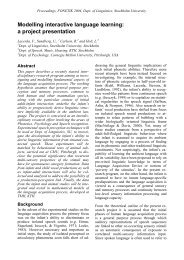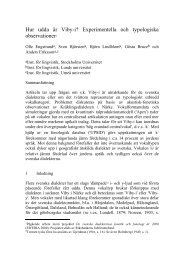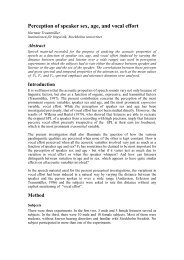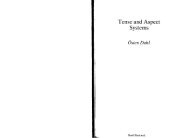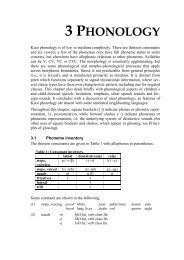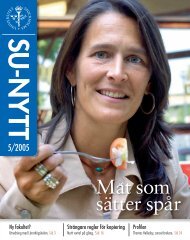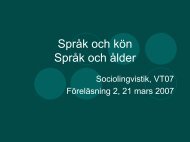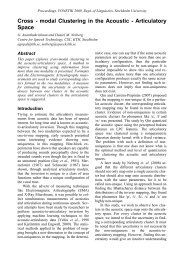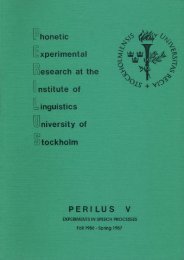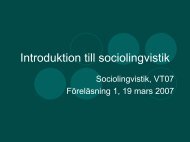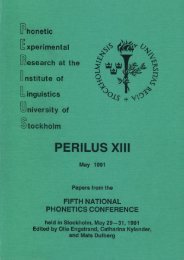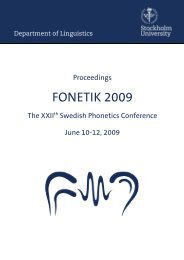The acoustics of Estonian Swedish long close vowels as compared ...
The acoustics of Estonian Swedish long close vowels as compared ...
The acoustics of Estonian Swedish long close vowels as compared ...
You also want an ePaper? Increase the reach of your titles
YUMPU automatically turns print PDFs into web optimized ePapers that Google loves.
Proceedings, FONETIK 2009, Dept. <strong>of</strong> Linguistics, Stockholm University<br />
<strong>The</strong> <strong>acoustics</strong> <strong>of</strong> <strong>Estonian</strong> <strong>Swedish</strong> <strong>long</strong> <strong>close</strong> <strong>vowels</strong><br />
<strong>as</strong> <strong>compared</strong> to Central <strong>Swedish</strong> and Finland <strong>Swedish</strong><br />
Eva Liina Asu 1 , Susanne Schötz 2 and Frank Kügler 3<br />
1 Institute <strong>of</strong> <strong>Estonian</strong> and General Linguistics, University <strong>of</strong> Tartu<br />
2 Department <strong>of</strong> Linguistics and Phonetics, Centre for Languages and Literature, Lund University<br />
3 Department <strong>of</strong> Linguistics, Potsdam University<br />
Abstract<br />
This pilot study investigates the phonetic realisation<br />
<strong>of</strong> <strong>Estonian</strong> <strong>Swedish</strong> <strong>long</strong> <strong>close</strong> <strong>vowels</strong><br />
comparing them with Central <strong>Swedish</strong> and Finland<br />
<strong>Swedish</strong> counterparts. It appears that in<br />
the Rickul variety <strong>of</strong> <strong>Estonian</strong> <strong>Swedish</strong> there is<br />
a distinction between only three <strong>long</strong> <strong>close</strong><br />
<strong>vowels</strong>. <strong>The</strong> analysed <strong>vowels</strong> <strong>of</strong> <strong>Estonian</strong> <strong>Swedish</strong><br />
are more similar to those <strong>of</strong> Central <strong>Swedish</strong><br />
than Finland <strong>Swedish</strong>, <strong>as</strong> me<strong>as</strong>ured by the<br />
Euclidean distance. Further research with<br />
more data is needed to establish the exact<br />
vowel space and phonetic characteristics <strong>of</strong> <strong>Estonian</strong><br />
<strong>Swedish</strong> dialects.<br />
Introduction<br />
This study is a first step in documenting the<br />
phonetic characteristics <strong>of</strong> <strong>Estonian</strong> <strong>Swedish</strong><br />
(ES), a highly endangered variety <strong>of</strong> <strong>Swedish</strong><br />
spoken historically on the islands and western<br />
co<strong>as</strong>t <strong>of</strong> Estonia. Despite its once flourishing<br />
status, ES is at present on the verge <strong>of</strong> extinction.<br />
Most <strong>of</strong> the <strong>Estonian</strong> <strong>Swedish</strong> community<br />
fled to Sweden during WWII. Today only a<br />
handful <strong>of</strong> elderly native ES speakers remain in<br />
Estonia, and about a hundred in Sweden.<br />
ES h<strong>as</strong> received surprisingly little attention<br />
and w<strong>as</strong> not, for instance, included in the<br />
SweDia 2000 project (Bruce et al., 1999) because<br />
there were no speakers from younger<br />
generations. To our knowledge, ES h<strong>as</strong> not<br />
been analysed acoustically before; all the existing<br />
work on its sound system h<strong>as</strong> been conducted<br />
in the descriptive framework <strong>of</strong> dialect<br />
research (e.g. E. Lagman, 1979). <strong>The</strong>refore, the<br />
aim <strong>of</strong> this study is to carry out the first acoustic<br />
analysis <strong>of</strong> ES by examining the quality <strong>of</strong><br />
<strong>close</strong> <strong>vowels</strong>. In this pilot study we will focus<br />
on ES <strong>long</strong> <strong>close</strong> <strong>vowels</strong> comparing them to<br />
those <strong>of</strong> Finland <strong>Swedish</strong> (FS) and Central<br />
<strong>Swedish</strong> (CS), the two varieties <strong>of</strong> <strong>Swedish</strong> that<br />
have had most influence on ES in recent times.<br />
<strong>Swedish</strong> is unique among world’s languages<br />
because <strong>of</strong> a number <strong>of</strong> phonologically distinct<br />
contr<strong>as</strong>ts in the inventory <strong>of</strong> <strong>close</strong> <strong>vowels</strong> (cf.<br />
Ladefoged and Maddieson, 1996). It h<strong>as</strong> been<br />
shown, however, that there is considerable<br />
variation in the realisation <strong>of</strong> these contr<strong>as</strong>ts<br />
depending on the variety <strong>of</strong> <strong>Swedish</strong> (Elert,<br />
2000, Kuronen, 2001). Thus, the study <strong>of</strong> <strong>close</strong><br />
<strong>vowels</strong> seems like a good place where to start<br />
the acoustic analysis <strong>of</strong> ES sound system.<br />
General Characteristics <strong>of</strong> <strong>Estonian</strong><br />
<strong>Swedish</strong><br />
<strong>Swedish</strong> settlers started arriving in Estonia in<br />
the Middle Ages. During several centuries, they<br />
continued coming from various parts in Sweden<br />
and Finland bringing different dialects which<br />
influenced the development <strong>of</strong> separate ES varieties.<br />
ES dialects are usually divided into four<br />
dialect are<strong>as</strong> on the b<strong>as</strong>is <strong>of</strong> their sound system<br />
and vocabulary (see Figure 1).<br />
Figure 1. <strong>The</strong> main dialect are<strong>as</strong> <strong>of</strong> <strong>Estonian</strong> <strong>Swedish</strong><br />
in the 1930s (from E. Lagman 1979: 2).
Proceedings, FONETIK 2009, Dept. <strong>of</strong> Linguistics, Stockholm University<br />
<strong>The</strong> largest area is the Nuckö-Rickul-Ormsö<br />
area (including Dagö) followed by the Rågö-<br />
Korkis-Vippal area. Separate dialect are<strong>as</strong> are<br />
formed by the Island <strong>of</strong> Runö and the Island <strong>of</strong><br />
Nargö. E. Lagman (1979: 5) claims that connections<br />
between the different dialect are<strong>as</strong><br />
were not particularly lively which made it possible<br />
for the separate dialects to retain their<br />
characteristic traits up to modern times.<br />
Another factor which h<strong>as</strong> shaped ES is the<br />
fact that until the 20th century, ES dialects<br />
were almost completely isolated from varieties<br />
<strong>of</strong> <strong>Swedish</strong> in Sweden, and therefore did not<br />
participate in several linguistic changes that occurred<br />
for instance in Standard <strong>Swedish</strong> (Tiberg,<br />
1962: 13, Haugen, 1976), e.g. the Great<br />
Quantity shift that took place in most Scandinavian<br />
varieties between 1250 and 1550. ES, <strong>as</strong><br />
opposed to Standard <strong>Swedish</strong>, h<strong>as</strong> retained the<br />
archaic ‘falling’ diphthongs, e.g. stain ‘sten’<br />
(stone), haim ‘hem’ (home) (E. Lagman, 1979:<br />
47). Starting from the end <strong>of</strong> the 19th century,<br />
however, ES came gradually in <strong>close</strong>r contact<br />
with above all Stockholm <strong>Swedish</strong> and Finland<br />
<strong>Swedish</strong>. It w<strong>as</strong> also around that time that the<br />
so called ‘high’ variety <strong>of</strong> ES (den estlandssvenska<br />
högspråksvarianten) appeared in<br />
connection with the development <strong>of</strong> the education<br />
system. This w<strong>as</strong> the regional standard that<br />
w<strong>as</strong> used <strong>as</strong> a common language within the ES<br />
community.<br />
According to E. Lagman (1979: 5) the main<br />
features <strong>of</strong> ES dialects resemble most those <strong>of</strong><br />
the variety <strong>of</strong> <strong>Swedish</strong> spoken in Nyland in<br />
South Finland. Lexically and semantically, the<br />
ES dialects have been found to agree with Finland<br />
<strong>Swedish</strong> and North <strong>Swedish</strong> (Norrbotten)<br />
dialects on the one hand, and with dialects in<br />
E<strong>as</strong>t Central (Uppland) and West (Götaland)<br />
Sweden and the Island <strong>of</strong> Gotland on the other<br />
hand (Bleckert, 1986: 91). It h<strong>as</strong> been claimed<br />
that the influence <strong>of</strong> <strong>Estonian</strong> on the sound system<br />
<strong>of</strong> ES is quite extensive (Danell, 1905-34,<br />
ref. in H. Lagman, 1971: 13) although it h<strong>as</strong> to<br />
be noted that the degree <strong>of</strong> language contact<br />
with <strong>Estonian</strong> varied considerably depending<br />
on the dialect area (E. Lagman, 1979: 4).<br />
<strong>Swedish</strong> <strong>long</strong> <strong>close</strong> <strong>vowels</strong><br />
Of the three varieties <strong>of</strong> <strong>Swedish</strong> included in<br />
the present study, it is the CS <strong>close</strong> <strong>vowels</strong> that<br />
have been subject to most extensive acoustic<br />
and articulatory analyses. Considerably less is<br />
known about FS <strong>vowels</strong>, and no acoustic data is<br />
so far available for ES <strong>vowels</strong>.<br />
CS exhibits a phonological four way contr<strong>as</strong>t<br />
in <strong>close</strong> <strong>vowels</strong> /iː – yː – ʉː – uː/ where /<br />
iː/, / yː/ and /ʉː/ are front <strong>vowels</strong> with many<br />
similar articulatory and acoustic features, and<br />
/uː/ is a back vowel (Riad, 1997). While /iː/ is<br />
considered an unrounded vowel and /yː/ its<br />
rounded counterpart, /ʉː/ h<strong>as</strong> been referred to<br />
<strong>as</strong>: (1) a labialised palatal vowel with a tongue<br />
position similar (but slightly higher) to [ø:], but<br />
with a difference in lip closure (Malmberg,<br />
1966: 99-100), (2) a <strong>close</strong> rounded front vowel,<br />
more open than [iː] and [yː] (Elert, 2000: 28;<br />
31; 49), (3) a further back vowel pronounced<br />
with pursed lips (hopsnörpning) rather than lip<br />
protrusion <strong>as</strong> is the c<strong>as</strong>e with /yː/ (Kuronen,<br />
2000: 32), and (4) a protruded (framskjuten)<br />
central rounded vowel (Engstrand, 2004: 113).<br />
<strong>The</strong> two <strong>vowels</strong> /iː/ and /yː/ display similar<br />
F1 and F2 values (Fant, 1969), and can be separated<br />
only by F3, which is lower for /y:/.<br />
Malmberg (1966: 101) argues that the only<br />
relevant phonetic difference between /ʉ:/ and<br />
/y:/ can be seen in the F2 and F3 values.<br />
An additional characteristic <strong>of</strong> <strong>long</strong> <strong>close</strong><br />
<strong>vowels</strong> in CS is that they tend to be diphthongised.<br />
Lowering <strong>of</strong> the first three formants at the<br />
end <strong>of</strong> the diphthongised <strong>vowels</strong> /ʉː/ and /uː/<br />
h<strong>as</strong> been reported by e.g. Kuronen (2000: 81-<br />
82), while the diphthongisation <strong>of</strong> /iː/ and /yː/<br />
results in a higher F1 and lower F2 at the end <strong>of</strong><br />
the vowel (Kuronen, 2000: 88).<br />
In FS, the <strong>close</strong> <strong>vowels</strong> differ somewhat<br />
from the CS ones, except /u:/ that is rather similar<br />
in both varieties. FS /iː/ and /yː/ are pronounced<br />
more open and further front than their<br />
CS counterparts. Acoustically, these <strong>vowels</strong> are<br />
realised with lower F1 and higher F2 values<br />
than in CS (Kuronen, 2000: 59). In FS, the<br />
<strong>close</strong> central /ʉː/ is pronounced further back<br />
than in CS (Kuronen, 2000: 60; 177). <strong>The</strong>re is<br />
some debate over <strong>as</strong> to whether the characteristics<br />
<strong>of</strong> FS are a result <strong>of</strong> language contact with<br />
Finnish (Kuronen, 2000: 60) or an independent<br />
dialectal development (Niemi, 1981).<br />
<strong>The</strong> quality <strong>of</strong> the rounded front vowel /yː/<br />
in the ‘high’ variety <strong>of</strong> ES is more open than in<br />
Standard <strong>Swedish</strong> (Lagman, 1979: 9). <strong>The</strong><br />
rounded front vowel /yː/ is said to be missing in<br />
ES dialects (Tiberg, 1962: 45, E. Lagman,<br />
1979: 53) and the word by (village) is pronounced<br />
with an /iː/. It seems, though, that the<br />
exact realisation <strong>of</strong> the vowel is heavily dependent<br />
on its segmental context and the dialect,<br />
and most probably also historical sound<br />
changes. Thus, in addition to [iː] /yː/ can be realised<br />
<strong>as</strong> [eː], [ɛː], or [ʉː] or <strong>as</strong> a diphthong
Proceedings, FONETIK 2009, Dept. <strong>of</strong> Linguistics, Stockholm University<br />
[iœː] or [iʉː] (for examples see E. Lagman,<br />
1979: 53). Considering this variation, it is<br />
nearly impossible to predict how /yː/ might be<br />
realised in our ES data. B<strong>as</strong>ed on E. Lagman’s<br />
comment (1979: 5) about ES being most similar<br />
to the Nyland variety <strong>of</strong> FS, we can hypothesise<br />
that ES <strong>vowels</strong> would be realised<br />
<strong>close</strong>r to those <strong>of</strong> FS than CS. Yet, we would<br />
not expect exactly the same distribution <strong>of</strong><br />
<strong>close</strong> <strong>vowels</strong> in ES <strong>as</strong> in FS or CS.<br />
Materials and method<br />
Speech data<br />
As materials the word list from the SweDia<br />
2000 datab<strong>as</strong>e w<strong>as</strong> used. <strong>The</strong> data comprised<br />
three repetitions <strong>of</strong> four words containing <strong>long</strong><br />
<strong>close</strong> <strong>vowels</strong>: dis (mist), typ (type), lus (louse),<br />
sot (soot). When recording the ES speakers, the<br />
word list had to be adapted slightly because not<br />
all the words in the list appear in ES vocabulary.<br />
<strong>The</strong>refore, dis w<strong>as</strong> replaced by ris (rice),<br />
typ by nyp (pinch) and sot by mot (against).<br />
Four elderly ES speakers (2 women and 2<br />
men) were recorded in a quiet setting in Stockholm<br />
in March 2009. All the speakers had arrived<br />
in Sweden in the mid 1940s <strong>as</strong> youngsters<br />
and were between 80 and 86 years old (mean<br />
age 83) at the time <strong>of</strong> recording. <strong>The</strong>y represent<br />
the largest dialect area <strong>of</strong> ES, the Rickul variety,<br />
having all been born there (also all their<br />
parents came from Rickul). <strong>The</strong> ES speakers<br />
were recorded using the same equipment <strong>as</strong> for<br />
collecting the SweDia 2000 datab<strong>as</strong>e: a Sony<br />
portable DAT recorder TCD-D8 and Sony tiepin<br />
type condenser microphones ECM-T140.<br />
For the comparison with CS and FS the<br />
word list data from the SweDia 2000 datab<strong>as</strong>e<br />
from two locations w<strong>as</strong> used: Borgå in Nyland<br />
w<strong>as</strong> selected to represent FS, while CS w<strong>as</strong> represented<br />
by Kårsta near Stockholm. From each<br />
<strong>of</strong> these locations the recordings from 3 older<br />
women and 3 older men were analysed. <strong>The</strong><br />
Borgå speakers were between 53 and 82 years<br />
old (mean age 73), and the Kårsta speakers between<br />
64 and 74 years old (mean age 67).<br />
Analysis<br />
<strong>The</strong> ES data w<strong>as</strong> manually labelled and segmented,<br />
and the individual repetitions <strong>of</strong> the<br />
words containing <strong>long</strong> <strong>close</strong> <strong>vowels</strong> were extracted<br />
and saved <strong>as</strong> separate sound and annotation<br />
files. Equivalent CS and FS data w<strong>as</strong> extracted<br />
from the SweDia datab<strong>as</strong>e using a Praat<br />
script. <strong>The</strong> segmentation w<strong>as</strong> manually checked<br />
and corrected.<br />
A Praat script w<strong>as</strong> used for obtaining the<br />
values for the first three formant frequencies<br />
(F1, F2, F3) <strong>of</strong> each vowel with the Burg<br />
method. <strong>The</strong> me<strong>as</strong>urements were taken at the<br />
mid-point <strong>of</strong> each vowel. All formant values<br />
were subsequently checked and implausible or<br />
deviant frequencies re-me<strong>as</strong>ured and corrected<br />
by hand. Mean values were calculated for the<br />
female and male speakers for each variety.<br />
One-Bark vowel circles were plotted for the<br />
female and male target <strong>vowels</strong> [iː, yː, ʉː, uː] <strong>of</strong><br />
each variety on separate F1/F2 and F2/F3 plots<br />
using another Praat script.<br />
In order to test for statistically significant<br />
differences between the dialects a two-way<br />
ANOVA w<strong>as</strong> carried out with the betweensubjects<br />
factors dialect (3) and gender (2), and<br />
a dependent variable formant (3).<br />
Finally, a comparison <strong>of</strong> the inventory <strong>of</strong><br />
<strong>long</strong> <strong>close</strong> <strong>vowels</strong> in the three varieties w<strong>as</strong><br />
conducted using the Euclidean distance, which<br />
w<strong>as</strong> calculated for the first three formants b<strong>as</strong>ed<br />
on values in Bark.<br />
Results<br />
Figure 2 plots the F1 and F2 values separately<br />
for female and male speakers for each <strong>of</strong> the<br />
three dialects. It can be seen that the distribution<br />
is roughly similar for both female and male<br />
speakers in all varieties.<br />
<strong>The</strong>re is a significant effect <strong>of</strong> dialect on F2<br />
for the vowel /iː/ (F(2, 10) = 8.317, p
Proceedings, FONETIK 2009, Dept. <strong>of</strong> Linguistics, Stockholm University<br />
Figure 2. F1/F2 plots <strong>of</strong> <strong>long</strong> <strong>close</strong> <strong>vowels</strong> for female and male speakers <strong>of</strong> <strong>Estonian</strong> <strong>Swedish</strong>, Finland<br />
<strong>Swedish</strong> and Central <strong>Swedish</strong>.<br />
Figure 3. F2/F3 plots <strong>of</strong> <strong>long</strong> <strong>close</strong> <strong>vowels</strong> for female and male speakers <strong>of</strong> <strong>Estonian</strong> <strong>Swedish</strong>, Finland<br />
<strong>Swedish</strong> and Central <strong>Swedish</strong>.
Proceedings, FONETIK 2009, Dept. <strong>of</strong> Linguistics, Stockholm University<br />
Figure 4. <strong>The</strong> Euclidean distance for the first three<br />
formants (in Bark) for female and male speakers.<br />
Figure 4 shows the Euclidean distance between<br />
dialects <strong>of</strong> <strong>long</strong> <strong>close</strong> <strong>vowels</strong> for female and<br />
male speakers. <strong>The</strong> black bars display the distance<br />
between ES and CS, grey bars between<br />
ES and FS, and white bars between CS and FS.<br />
Except for /iː/ in female speakers, the <strong>long</strong><br />
<strong>close</strong> <strong>vowels</strong> <strong>of</strong> ES are <strong>close</strong>r to CS than to FS<br />
(a two-tailed t-test reveals a trend towards significance;<br />
t=-1.72, p=0.062).<br />
Discussion<br />
Our results show that at le<strong>as</strong>t this variety <strong>of</strong> ES<br />
(Rickul) h<strong>as</strong> only three distinct <strong>close</strong> <strong>vowels</strong>:<br />
/iː/, /yː/ and /uː/. <strong>The</strong>re is an almost complete<br />
overlap <strong>of</strong> the target <strong>vowels</strong> [yː] and [ʉː] in ES.<br />
<strong>The</strong> plotted F1/F2 vowel space <strong>of</strong> <strong>close</strong> ES<br />
<strong>vowels</strong> bears a striking resemblance to that <strong>of</strong><br />
<strong>Estonian</strong> which also distinguishes between the<br />
same three <strong>close</strong> <strong>vowels</strong> (cf. Eek and Meister,<br />
1998).<br />
As pointed out above, earlier descriptions <strong>of</strong><br />
ES refer to the varying quality <strong>of</strong> /yː/ in different<br />
dialects (cf. E. Lagman 1979: 53). Auditory<br />
analysis <strong>of</strong> the vowel sound in the word nyp<br />
reveals that the vowel is actually realised <strong>as</strong> a<br />
diphthong [iʉː] by all our ES speakers, but <strong>as</strong><br />
we only me<strong>as</strong>ured the quality <strong>of</strong> the second part<br />
<strong>of</strong> the diphthong (at only one point in the<br />
vowel), our me<strong>as</strong>urements do not reflect diphthongisation.<br />
It is also possible that if a different<br />
test word had been chosen the quality <strong>of</strong> the<br />
/yː/ would have been different.<br />
Similarily, the present analysis does not<br />
capture the diphthongisation that is common in<br />
CS <strong>long</strong> <strong>close</strong> <strong>vowels</strong>.<br />
As shown by earlier studies (e.g. Fant, et al.<br />
1969) the <strong>close</strong> front vowel space in CS is<br />
crowded on the F1/F2 dimension, and there is<br />
no clear separation <strong>of</strong> /iː/ and /yː/. In our data,<br />
there also occurs an overlap <strong>of</strong> [iː] and [yː] with<br />
[ʉː] for female CS speakers. All three <strong>vowels</strong><br />
are, however, separated nicely by the F3 dimension.<br />
It is perhaps worth noting that the mean F2<br />
for /iː/ is somewhat lower for CS female speakers<br />
than male speakers. This difference is<br />
probably due to one <strong>of</strong> the female speakers who<br />
realised her /iː/ <strong>as</strong> the so called Viby /iː/ which<br />
is pronounced <strong>as</strong> [ɨː].<br />
Our results confirm that the FS /ʉː/ is a<br />
<strong>close</strong> central vowel that is acoustically <strong>close</strong>r to<br />
[uː] than to [yː] (cf. Kuronen, 2000: 136), and<br />
significantly different from the realisations <strong>of</strong><br />
the target vowel /ʉː/ in the other two varieties<br />
under question.<br />
<strong>The</strong> comparison <strong>of</strong> ES with CS and FS by<br />
means <strong>of</strong> the Euclidean distance allowed us to<br />
<strong>as</strong>sess the proximity <strong>of</strong> ES <strong>vowels</strong> with the<br />
other two varieties. Interestingly, it seems that<br />
the results <strong>of</strong> the comparison point to less distance<br />
between ES and CS than between ES and<br />
FS. This is contrary to our initial hypothesis<br />
b<strong>as</strong>ed on E. Lagman’s (1979: 5) observation<br />
that the main dialectal features <strong>of</strong> ES resemble<br />
most FS. However, this does not necessarily<br />
mean that the language contact between CS and<br />
ES must account for these similarities. Given<br />
that the ES <strong>vowels</strong> also resemble <strong>Estonian</strong><br />
<strong>vowels</strong> a detailed acoustic comparison with <strong>Estonian</strong><br />
<strong>vowels</strong> would yield a more coherent picture<br />
on this issue.<br />
Conclusions<br />
This paper h<strong>as</strong> studied the acoustic characteristics<br />
<strong>of</strong> <strong>long</strong> <strong>close</strong> <strong>vowels</strong> in <strong>Estonian</strong> <strong>Swedish</strong><br />
(ES) <strong>as</strong> <strong>compared</strong> to Finland <strong>Swedish</strong> (Borgå)<br />
and Central <strong>Swedish</strong> (Kårsta). <strong>The</strong> data for the<br />
analysis w<strong>as</strong> extracted from the elicited word<br />
list used for the SweDia 2000 datab<strong>as</strong>e. <strong>The</strong><br />
same materials were used for recording the<br />
Rickul variety <strong>of</strong> ES.<br />
<strong>The</strong> analysis showed that the inventory <strong>of</strong><br />
<strong>long</strong> <strong>close</strong> <strong>vowels</strong> in ES includes three <strong>vowels</strong>.<br />
Comparison <strong>of</strong> the <strong>vowels</strong> in the three varieties<br />
in terms <strong>of</strong> Euclidean distance revealed that the<br />
<strong>long</strong> <strong>close</strong> <strong>vowels</strong> in ES are more similar to<br />
those <strong>of</strong> CS than FS.
Proceedings, FONETIK 2009, Dept. <strong>of</strong> Linguistics, Stockholm University<br />
Much work remains to be done in order to<br />
reach a comprehensive phonetic analysis <strong>of</strong> ES<br />
<strong>vowels</strong>. More speakers need to be recorded<br />
from different varieties <strong>of</strong> ES to examine in<br />
<strong>close</strong>r detail the dialectal variation within ES.<br />
In the following work on ES <strong>vowels</strong>, we are<br />
planning to carry out dynamic formant analysis<br />
in order to capture possible diphthongisation <strong>as</strong><br />
well <strong>as</strong> speaker variation.<br />
Acknowledgements<br />
We would like to thank Joost van de Weijer for<br />
help with statistical analysis, Gösta Bruce for<br />
advice and discussing various <strong>as</strong>pects <strong>of</strong> <strong>Swedish</strong><br />
<strong>vowels</strong>, and Francis Nolan for his comments<br />
on a draft <strong>of</strong> this paper. We are also very<br />
grateful to our <strong>Estonian</strong> <strong>Swedish</strong> subjects who<br />
willingly put up with our recording sessions.<br />
We owe a debt to Ingegerd Lindström and Göte<br />
Brunberg at Svenska Odlingens Vänner – the<br />
<strong>Estonian</strong> Swedes’ cultural organisation in<br />
Stockholm – for hosting the <strong>Estonian</strong> <strong>Swedish</strong><br />
recording sessions. <strong>The</strong> work on this paper w<strong>as</strong><br />
supported by the <strong>Estonian</strong> Science Foundation<br />
grant no. 7904, and a scholarship from the<br />
Royal <strong>Swedish</strong> Academy <strong>of</strong> Letters, History<br />
and Antiquities.<br />
References<br />
Bleckert L. (1986) Ett komplement till den europeiska<br />
språkatl<strong>as</strong>en (ALE): Det estlandssvenska<br />
materialet till första volymserien<br />
(ALE I 1). <strong>Swedish</strong> Dialects and Folk<br />
Traditions 1985, Vol. 108. Uppsala: <strong>The</strong> Institute<br />
<strong>of</strong> Dialect and Folklore Research.<br />
Bruce G., Elert C.-C., Engstrand O., and Eriksson<br />
A. (1999) Phonetics and phonology <strong>of</strong><br />
the <strong>Swedish</strong> dialects – a project presentation<br />
and a datab<strong>as</strong>e demonstrator. Proceedings<br />
<strong>of</strong> ICPhS 99 (San Francisco), 321–324.<br />
Danell G. (1905–34) Nuckömålet I–III. Stockholm.<br />
Eek A., Meister E. (1998) Quality <strong>of</strong> Standard<br />
<strong>Estonian</strong> <strong>vowels</strong> in stressed and unstressed<br />
syllables <strong>of</strong> the feet in three distinctive<br />
quantity degrees. Linguistica Uralica 34, 3,<br />
226–233.<br />
Elert C.-C. (2000) Allmän och svensk fonetik.<br />
Stockholm: Norstedts.<br />
Engstrand O. (2004) Fonetikens grunder. Lund:<br />
Studentlitteratur.<br />
Fant G., Henningson G., Stålhammar U. (1969)<br />
Formant Frequencies <strong>of</strong> <strong>Swedish</strong> Vowels.<br />
STL-QPSR 4, 26–31.<br />
Haugen E. (1976) <strong>The</strong> Scandinavian languages:<br />
an introduction to their history. London:<br />
Faber & Faber.<br />
Kuronen M. (2000) Vokaluttalets akustik i<br />
sverigesvenska, finlandssvenska och finska.<br />
Studia Philologica Jyväskyläensia 49.<br />
Jyväskylä: University <strong>of</strong> Jyväskylä.<br />
Kuronen M. (2001) Acoustic character <strong>of</strong><br />
vowel pronunciation in Sweden-<strong>Swedish</strong><br />
and Finland-<strong>Swedish</strong>. Working papers,<br />
Dept. <strong>of</strong> Linguistics, Lund University 49,<br />
94–97.<br />
Ladefoged P., Maddieson I. (1996) <strong>The</strong> Sounds<br />
<strong>of</strong> the World’s Languages. Oxford: Blackwell.<br />
Lagman E. (1979) En bok om Estlands svenskar.<br />
Estlandssvenskarn<strong>as</strong> språkförhållanden.<br />
3A. Stockholm: Kulturföreningen<br />
Svenska Odlingens Vänner.<br />
Lagman H. (1971) Svensk-estnisk språkkontakt.<br />
Studier över estniskans inflytande på<br />
de estlandssvenska dialekterna. Stockholm.<br />
Malmberg B. (1966) Nyare fonetiska rön och<br />
andra uppsatser i allmän och svensk fonetik.<br />
Lund: Gleerups.<br />
Niemi S. (1981) Sverigesvenskan, finlandssvenskan<br />
och finskan som kvalitets-<br />
och kvantitetsspråk. Akustiska iakttagelser.<br />
Folkmålsstudier 27, Meddelanden från<br />
Föreningen för nordisk filologi. Åbo: Åbo<br />
Akademi, 61–72.<br />
Riad T. (1997) Svensk fonologikompendium.<br />
University <strong>of</strong> Stockholm.<br />
Tiberg N. (1962) Estlandssvenska språkdrag.<br />
Lund: Carl Bloms Boktryckeri A.-B.



